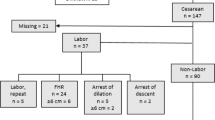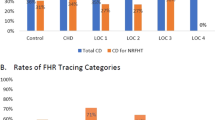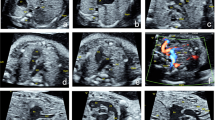Abstract
Objective:
To determine the mode of delivery in pregnancies complicated by complex fetal congenital heart disease (CHD).
Study Design:
Five-year retrospective cohort study at a tertiary fetal medicine center (2007 to 2011). Cases of complex fetal CHD (n=126) were compared with 45 069 non-anomalous singleton infants ⩾500 g to determine rates of emergency intrapartum cesarean section (CS), preterm delivery and induction of labor.
Result:
Intrapartum CS is significantly higher in fetal CHD than non-anomalous controls (21% vs 13.5%, odds ratio (OR) 1.7, 95% confidence interval (CI): 1.0 to 2.7; P=0.035), predominantly related to CS for non-reassuring fetal status (OR 2.2, 95% CI: 1.1 to 4.1; P=0.022). Although fetal CHD did not increase emergency CS rates in nulliparous women, CS was significantly increased in multiparous pregnancies (OR 2.4, 95% CI: 1.8 to 4.6; P=0.014). Rates of preterm delivery (OR 3.4, 95% CI: 2.0 to 5.4; P<0.0001) and induction of labor (OR 1.9, 95% CI: 1.3 to 2.9; P=0.001) were higher in the CHD cases.
Conclusion:
Emergency CS is increased in fetal CHD, attributed to a higher rate of CS for non-reassuring fetal status and seen mostly in multiparous women.
This is a preview of subscription content, access via your institution
Access options
Subscribe to this journal
Receive 12 print issues and online access
$259.00 per year
only $21.58 per issue
Buy this article
- Purchase on Springer Link
- Instant access to full article PDF
Prices may be subject to local taxes which are calculated during checkout


Similar content being viewed by others
References
Berkley EM, Goens MB, Karr S, Rappaport V . Utility of fetal echocardiography in postnatal management of infants with prenatally diagnosed congenital heart disease. Prenat Diagn 2009; 29: 654–658.
Yeu BK, Chalmers R, Shekleton P, Grimwade J, Menahem S . Fetal cardiac diagnosis and its influence on the pregnancy and newborn—a tertiary center experience. Fetal Diagn Ther 2008; 24: 241–245.
Donofrio MT, Levy RJ, Schuette JJ, Skurow-Todd K, Sten MB, Stallings C et al. Specialized delivery room planning for fetuses with critical congenital heart disease. Am J Cardiol 2013; 111: 737–747.
Craigo SD . Indicated preterm birth for fetal anomalies. Semin Perinatol 2011; 35: 270–276.
Colby CE, Carey WA, Blumenfeld YJ, Hintz SR . Infants with prenatally diagnosed anomalies: special approaches to preparation and resuscitation. Clin Perinatol 2012; 39: 871–887.
Mellander M . Perinatal management, counselling and outcome of fetuses with congenital heart disease. Semin Fetal Neonat Med 2005; 10: 586–593.
Peterson AL, Quartermain MD, Ades A, Khalek N, Johnson MP, Rychik J . Impact of mode of delivery on markers of perinatal hemodynamics in infants with hypoplastic left heart syndrome. J Pediatr 2011; 159: 64–69.
Trento LU, Pruetz JD, Chang RK, Detterich J, Sklansky MS . Prenatal diagnosis of congenital heart disease: impact of mode of delivery on neonatal outcome. Prenat Diagn 2012; 32: 1250–1255.
Landis BJ, Levey A, Levasseur SM, Glickstein JS, Kleinman CS, Simpson LL et al. Prenatal diagnosis of congenital heart disease and birth outcomes. Pediatr Cardiol 2013; 34: 597–605.
Anagnostou K, Messenger L, Yates R, Kelsall W . Outcome of infants with prenatally diagnosed congenital heart disease delivered outside specialist pediatric cardiac centers. Arch Dis Childhood Fetal Neonat Ed 2013; 98: F218–F221.
Ray Chaudhuri Bhatta S, Keriakos R . Review of the recent literature on the mode of delivery for singleton vertex preterm babies. J Preg 2011; 2011: 186560.
Alfirevic Z, Milan SJ, Livio S . Cesarean section versus vaginal delivery for preterm birth in singletons. Cochrane Database System Rev 2012; 6: CD000078.
Cedergren MI, Kallen BA . Obstetric outcome of 6346 pregnancies with infants affected by congenital heart defects. Eur J Obstet Gynecol Reprod Biol 2006; 125: 211–216.
Ueda K, Ikeda T, Iwanaga N, Katsuragi S, Yamanaka K, Neki R et al. Intrapartum fetal heart rate monitoring in cases of congenital heart disease. Am J Obstet Gynecol 2009; 201: e1–e6.
Acknowledgements
We are grateful to Ms Fionnuala Byrne, Information Officer, National Maternity Hospital for her help with data collection and retrieval.
Author information
Authors and Affiliations
Corresponding author
Ethics declarations
Competing interests
The authors declare no conflict of interest.
Additional information
This study was presented in part at the 16th Annual Meeting of the British Maternal–Fetal Medicine Society in Dublin, Ireland, April 2013.
Rights and permissions
About this article
Cite this article
Walsh, C., MacTiernan, A., Farrell, S. et al. Mode of delivery in pregnancies complicated by major fetal congenital heart disease: a retrospective cohort study. J Perinatol 34, 901–905 (2014). https://doi.org/10.1038/jp.2014.104
Received:
Revised:
Accepted:
Published:
Issue Date:
DOI: https://doi.org/10.1038/jp.2014.104
This article is cited by
-
Maternal and neonatal factors associated with cesarean delivery in a cohort of pregnancies complicated by prenatally diagnosed congenital heart disease
Journal of Perinatology (2024)
-
Fetal congenital heart disease - mode of delivery and obstetrical complications
BMC Pregnancy and Childbirth (2022)
-
Neonatal and maternal outcomes of pregnancies with a fetal diagnosis of congenital heart disease using a standardized delivery room management protocol
Journal of Perinatology (2020)
-
Surgical Considerations and Management Options in Premature and Very Low Birth Weight Infants With Complex Congenital Heart Disease
Current Treatment Options in Pediatrics (2020)



